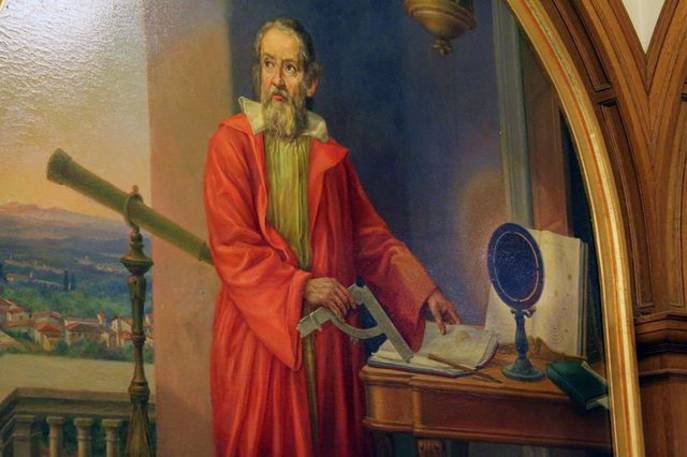


PADOVA -- This is the city where, for no less than 18 years, one of Italy's most brilliant citizens, Galileo Galilei [2], taught university students mathematics and mechanics. Padua [3] (hereafter Padova) was already famous throughout Europe for its deep culture and venerable university, which was what attracted Galileo there. For him, "Mathematics is the alphabet in which God wrote the Universe." Still, Galileo was incredibly multi-faceted, interested in philosophy as well as science and math. Not only was he beginning to study the Milky Way, but, to round out his professorial stipend, in Padova Galileo also wrote a treatise on military fortifications and, for money, horoscopes for private individuals.
Today, Padova celebrates Galileo in an imaginative exhibition just opened at the Palazzo del Monte di Pietà [4], "Rivoluzione Galileo: L'Arte Incontra la Scienza" (The Galileo Revolution: Art Encounters Science). Born in Pisa [5] in 1564, Galileo began his studies there but went on briefly to Florence and, in 1592, to Padova. There, we are told, he took benefit from the climate of relative religious tolerance permitted by the Venetian Republic, of which Padova was a part. These were, Galileo said later, "the best years of my entire life." Besides teaching, Galileo gave private lessons to illustrious locals including two future cardinals and at least two princes.
In the exhibition are some 200 pieces, which illustrate the fundamental passage from the age of astrology to astronomy -- that is, the skies before and after Galileo's discoveries of the mountains of the moon. "The exhibition is a voyage in art history about Galileo, scientist and man of letters, mathematician and artist, lover of the stars and of Ariosto" (Ariosto [6], the author of the drama in verse "L'Orlando Furioso"), writes Raffaele De Santis in a review of the exhibition.
On view is a 24-foot-long telescope made in the 1660s by pioneer optician and astronomer Giuseppe Campani [7], who was born near Spoleto before setting up his pioneering laboratory in Rome. Besides watercolors by Galileo himself, there are poetic (if not scientifically realistic) visions of the sky painted by Leonardo da Vinci, Durer, Brueghel the Younger and Rubens.
On April 12, 1633, Galileo was summoned to Rome by the Inquisition, the Holy Office (Santi Uffizi). In an article for the journal Church History last year, Prof. Henry Kelly of UCLA [8]wrote that, at that trial, Galileo said that after 1616 he had never considered heliocentrism to be possible. “Galileo was clearly stretching the truth... Admitting otherwise would have increased the penance he was given, but would not have endangered his life, since he agreed to renounce the heresy."
From the inquisitors came no threat of torture, says Prof. Kelly. Still, Galileo abjured but was found guilty of heresy on June 22, 1633. Ever since then writers have invented words for him, such as this version by Italian writer Primo Levi (1919 - 1987), the author of "Se questo è un uomo": "I have had to bow down and say that I did not see what I saw." Galileo was first held in the home of the Archbishop of Siena and then under house arrest at Arcetri on the Florentine Hills, where he died on January 8, 1642.
Exhibition visitors can also call in at those places in Padova associated with Galileo. After his arrival in Padua in 1592 Galileo lived for nine years in the House of Gianvincenzo Pinelli, Galileo's close friend. Pinelli was a humanist philosopher. (Humanistic studies are still taught including at the University of John Cabot in Rome.)
From 1601 through 1610 Galileo lived in a house across from a school, the G. Pascoli, on a street now named for Galileo. While observing the sky from his window and from the garden, he discovered the the moons of Jupiter. Another suggested visit is to Palazzo del Bo, which housed the University of Padova after 1493. The palazzo, with newly restored frescoes, still houses some university offices and the world's oldest anatomical theater for medical students.
Galileo's two children, Livia and Gianvincenzo, were baptized in the little Church of Santa Caterina on Via Cesare Battisti, in which the baptismal certificate of one is on view. The church, which dates from the 14th century, was seriously damaged by an earthquake in 1976 and recently restored. During the middle ages a college was attached to the church, and on Nov. 25 each year a university procession was held to inaugurate the academic year.
A fifth stop on the Galileo itinerary at Padua is the Vecchia Canonica, where the priest Don Paolo Gualdo, rector of the Padua cathedral (Duomo), met regularly with Galileo. And then there is the library of the Padova Seminary, the Biblioteca, in whose collection is a precious first edition of "Dialogue on Maximum Systems" of 1632, with handwritten notes by Galileo in the margins. Visitors are also encouraged to call at the Museum of Medicine (MUSME), where talks are offered on Galileo's influence on the science of medicine; his own first university years were in medical studies.
Curators are Carlo Federio Villa and Stefan Weppelmann. Sponsors of the exhibition, through March 18, 2018, are the Fondazione Cassa di Risparmio di Padova e Rovigo [9] in collaboration with the University of Padova. For further information, see www.mostrarivoluzionegalileo.it [10]
As an afterthought, in late 1991, Pope John Paul II oversaw the Church's rectifying the persecution that forced Galileo to recant. See: http://www.nytimes.com/1992/10/31/world/after-350-years-vatican-says-galileo-was-right-it-moves.html [11]
Source URL: http://440468.6bgr9ubv.asia/magazine/focus/art-culture/article/galileo-galilei-in-padova-best-years-my-life
Links
[1] http://440468.6bgr9ubv.asia/files/galileomuralmidjpg
[2] https://en.wikipedia.org/wiki/Galileo_Galilei
[3] https://en.wikipedia.org/wiki/Padua
[4] https://www.tripadvisor.com/Attraction_Review-g187867-d4101569-Reviews-Palazzo_del_Monte_di_Pieta-Padua_Province_of_Padua_Veneto.html
[5] https://en.wikipedia.org/wiki/Pisa
[6] https://en.wikipedia.org/wiki/Ludovico_Ariosto
[7] https://en.wikipedia.org/wiki/Giuseppe_Campani
[8] http://www.english.ucla.edu/all-faculty/213-kelly-henry-a
[9] http://www.fondazionecariparo.it/arte-e-cultura/
[10] http://www.mostrarivoluzionegalileo.it
[11] http://www.nytimes.com/1992/10/31/world/after-350-years-vatican-says-galileo-was-right-it-moves.html